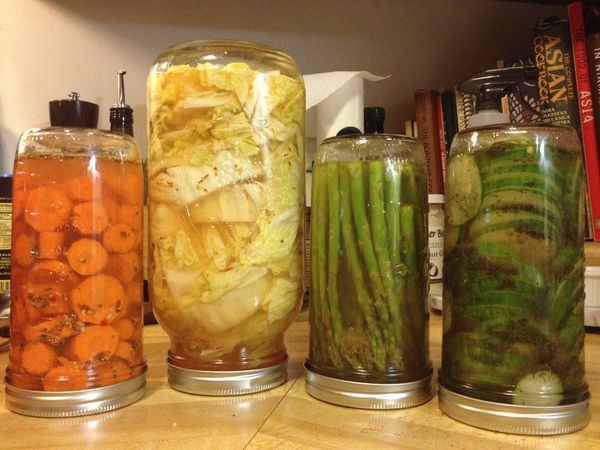News
Joe's Refrigerator Pickle Recipe
Wednesday, May 6, 2020

Refrigerator Pickles
Ó Joe Jencks, 2020
Many of you know I LOVE to cook. I love to cook even more than I love to eat. As such, cooking for a group of people is always fun because I can cook a lot – and then the food is gone, and there is a chance to cook some more. I am missing cooking for people. It is a love language. It is joyful service, and one of the ways I say, “I Love You.”
So, I thought I would start sharing more of what is happening with Adventure from Joe’s Kitchen. This week: Refrigerator Pickles. Carrots with some dried chili peppers and Montreal steak seasoning; Napa Cabbage (Kimchi-Style) with Sambal Olek chili paste, granulated garlic, a dash of fish sauce, and some dried chili flakes; Asparagus with rosemary, granulated garlic, a dash of dill; and English Cucumber with lots of dill, some granulate garlic, and Chipotle chili flakes.
My mom was a Master Canner. I spent what felt like weeks every summer and fall, helping with canning. Tomatoes in many forms (stewed, sauce, chili sauce, whole, diced, Tomato Marmalade – YUM!) as well as many other jams, jellies, apple sauce (including some with berries, rhubarb, pears, or other fruits), peaches and apricots, cherries, and of course phenomenal pickles. But when I am cooking for myself or just a few friends, canning on that scale is a lot of work. And I have found that a small amount of effort invested in micro-batches of Refrigerator Pickles, scratches that particular culinary itch.
This week I got on a late-night kick of making Refrigerator Pickles. I do this several times a year. And my style of making pickles is influenced by a combination something my Aunt Barbara made when I was a kid with fresh cucumbers, Korean kimchi, and Japanese style fresh pickles and “pressure” pickles. But I still invoke my mother’s sense of adventure in playing with ingredients and spices. It’s always delightful and usually a colorful adventure. Joyful.
I most frequently pickle Napa Cabbage (Kimchi style), cucumbers, or large Korean Radishes (a cousin of Japanese Daikon, only bigger and more bulbous. But you can pickle almost any veg, and figure out what flavors taste right to you, in what proportion. This week it was: English Cucumbers, Napa Cabbage, Asparagus, and Carrots. Next week, maybe some green cabbage (with caraway seeds, sauerkraut style) and some more green cabbage with a little sugar. (Like what a good Teriyaki place would serve. ALL cooking is subject to interpretation and improvisation in Joe’s kitchen. Sort of like music on Joe’s stage. You can rehearse, but it’s never quite the same two times in a row.
Here is the basic process:
*I take the veg, clean it, cut it up and put it in the jars.
*I then put a pinch of kosher rock salt and whatever spices, garlic, etc. I wish to add.
*Then I prepare a light brine of Water with some salt and distilled or light vinegar.
*I prepare this every time by taste.
*I will measure next time.
*But it should taste like pickle juice.
*Salty but not too salty, tart, but not too tart.
*Then I boil it good, and pour it over the veg and spices and herbs.
*Fill it to the top, or until all veg is covered.
*If possible fill the jar with brine to within about ¼ to ½ inch of the top.
*The fluid level will drop ever so little as it cools.
*Let it cool till you can hold the jar with your bare hands and it feels warm, not hot.
*Then put the canning lids on them, tight, but not ridiculous.
*Then I gently rotate the jars on several axis to mix all the stuff up in the canning jars.
*Then refrigerate for 24 hours.
*The next day, turn the jars a few times again to mix up the flavors and herbs and spices.
*Place them back in the refrigerator upside down.
*On day three, rotate them again to mix the stuff, and them leave them right-side up.
*On day 4, open and enjoy.
*Keep refrigerated when not using.
*There is usually not quite enough salt or vinegar or natural fermentation to keep Refrigerator Pickles out for days. But I also play with letting some of the Kimchi-Style pickles ferment just a little. They will eventually get a little mushy if not eaten. They RARELY last that long in my kitchen. But if they do, there are MANY Korean recipes that call for “Aged Kimchi” as part of sauces, broths, etc. So even fresh pickles that have become a little more fragrant, can still be pureed, sautéed, used in stir-fry, etc. The Korean radishes can become fragrant quite early on in the process. Don’t be alarmed. They are still totally edible and very yummy. Working in smaller batches at first is useful, till you get your sea-legs, and figure out what you like and what your rate of consumption is.
Experiment.
Enjoy!
~ Joe Jencks